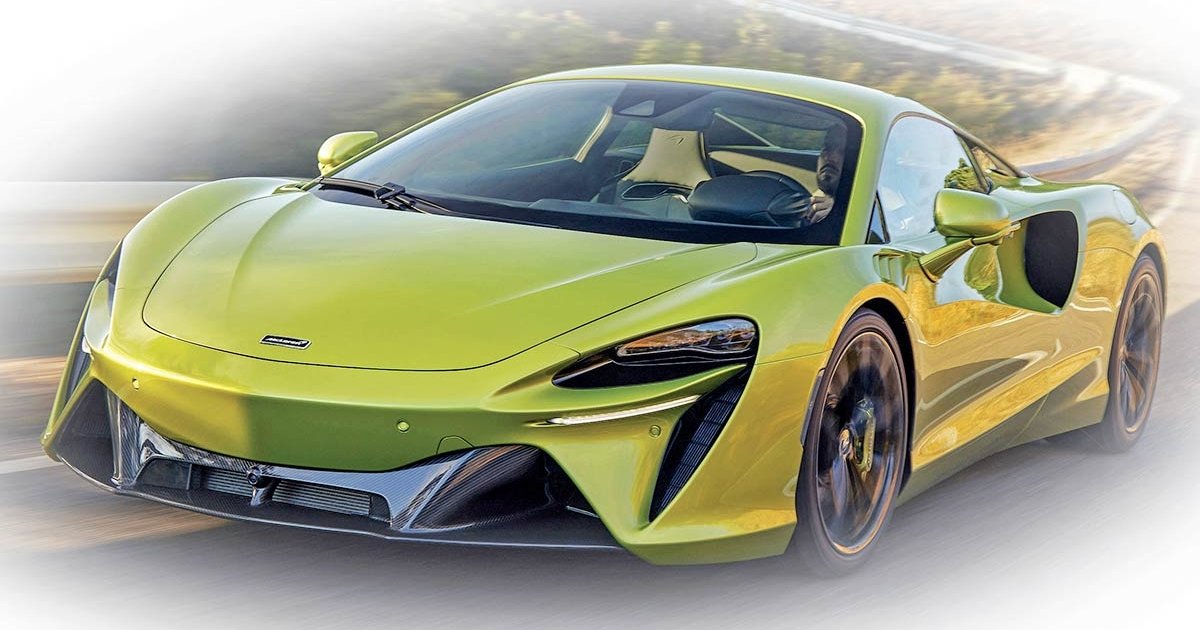
McLaren is positioning its supercar portfolio for the future as it shifts — gradually — from fossil fuel to electron power.
The British sports car marque seeks to transition to a 100 percent electrified portfolio by 2026, with the first full-electric model expected by decade’s end.
In the near term, McLaren is sticking with plug-in hybrid technology to help trim fleet emissions without compromising vehicle weight and driving performance.
McLaren will begin U.S. delivery of its plug-in hybrid Artura in late September.
A second PHEV — a successor to the P1 — follows around mid-decade.
McLaren is also ditching thirsty V-8s in future cars. Every new McLaren model will have a V-6 and hybrid system, according to TopGear.
And McLaren could be thinking beyond swoopy cars. It is reportedly considering an SUV model in the decade’s second half.
The McLaren SUV portfolio will start with one model that is “relatively low, compact” and with “dual- or tri-motor, four-wheel drive,” British magazine Autocar noted this summer. It will also be fully electric.
A McLaren spokesman dampened the speculation, noting there are “no immediate plans” for such a vehicle. A U.S. dealer said that if a McLaren SUV is greenlighted, it would be at least five years away.
But McLaren’s new boss, Michael Leiters, is an advocate of utility vehicles. He was instrumental in creating Porsche’s first crossover, the Cayenne, and Ferrari’s first utility, the Purosangue.
In an interview with Autocar, the CEO said he sees the SUV segment as “very attractive” and one that “continues to grow.”
“What we have to understand as McLaren is ‘how can we find a product that is in line with our DNA?’ ” Leiters said. “We shouldn’t do a classic SUV.”
Plug-in hybrid: The successor to the P1 could arrive in late 2024. It will be the latest in the Ultimate Series line. About 375 units are planned.
Artura: McLaren’s newest model suffered software and supply chain delays, but U.S. customers will take delivery soon.
The plug-in hybrid supercar introduces McLaren’s carbon lightweight architecture and combines a twin-turbocharged 3.0-liter V-6 engine — the first in a McLaren — with an electric motor and a 7.4-kilowatt-hour battery pack.
The powertrain delivers a combined output of 671 hp and can propel the sports car from 0 to 60 mph in three seconds. The Artura has a top speed of 205 mph and can travel up to 11 miles in EV-only mode.
A convertible variant should arrive in the second half of next year.
Elva: The newest addition to McLaren’s top-tier Ultimate Series is the Elva roadster. A twin-turbocharged V-8 supplies power with 804 hp.
Soft demand for the niche model and pandemic-related supply chain issues caused McLaren to reduce the Elva’s production run to 149 units from 399. The model is sold out, and deliveries ended this spring.
Solus GT: The track-only, single-seater brings to life a futuristic McLaren concept featured in the Gran Turismo Sport video game.
A naturally aspirated 5.2-liter V-10 engine delivers 840 hp and up to 479 pound-feet of torque. Weighing less than 2,205 pounds, the Solus GT can sprint from 0 to 62 mph in 2.5 seconds and hit a top speed of more than 200 mph.
The 25-unit production run is pre-sold. Deliveries begin next year.
765LT: The high-performance and lightweight variant of the 720S is powered by a twin-turbo V-8 engine with 755 hp and 590 pound-feet of torque, compared with the standard 720S’ 710 hp and 537 pound-feet of torque.
The 765LT Spider convertible arrived last year with a retractable hard top. McLaren will build 765 units globally, with production ending this year.
720S: The coupe and convertible variants will receive a minor update in the first half of next year, including new aerodynamic elements, infotainment upgrades and a horsepower bump. A redesign could come in late 2024.
GT: For the 2022 model, McLaren adds equipment, such as carbon-ceramic brakes, a nose lift and heated seats, as standard.
The grand tourer will receive a minor update in the second half of next year with upgraded engine performance and superficial design tweaks.
A redesign might follow in 2025.